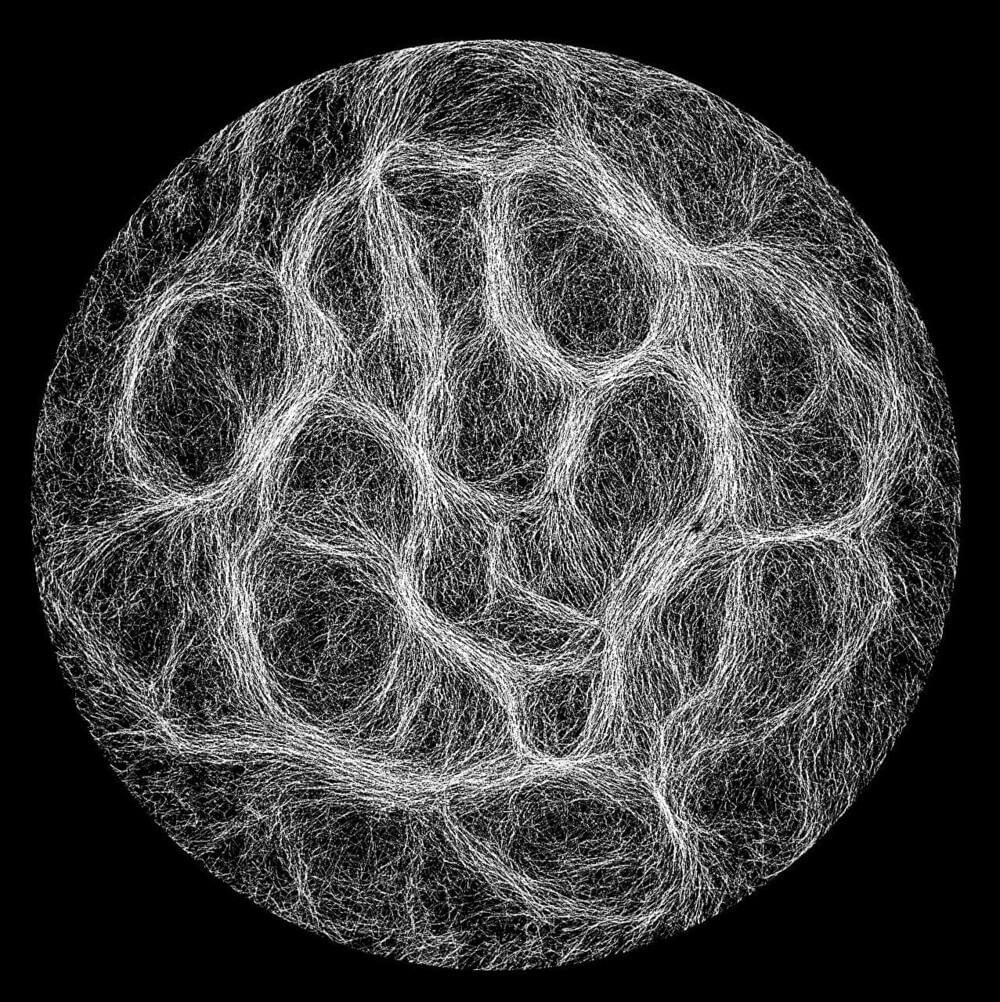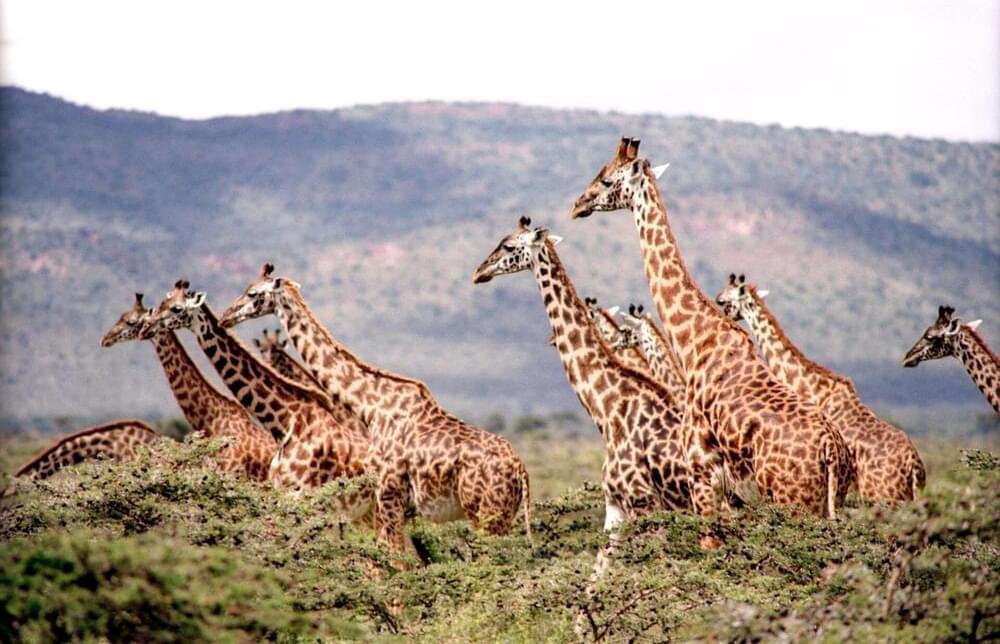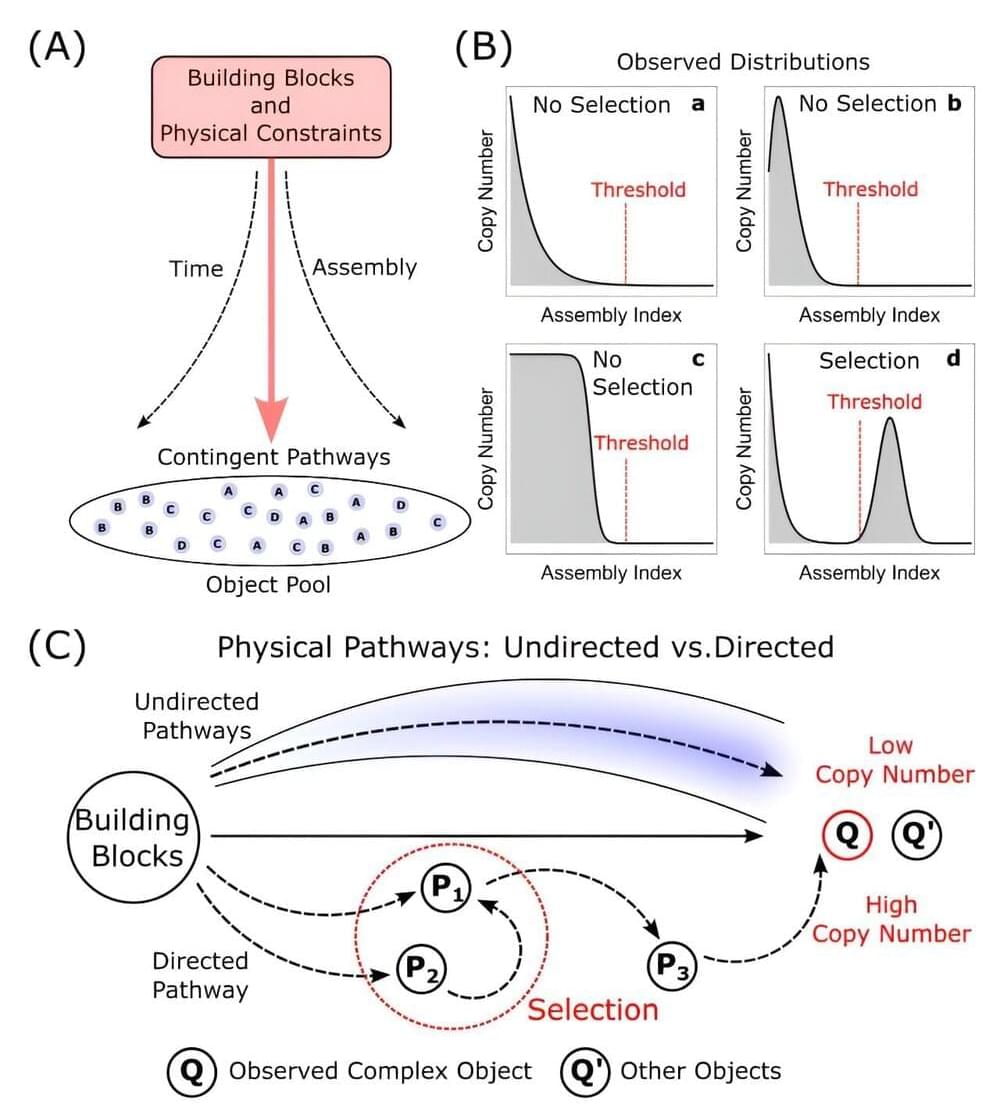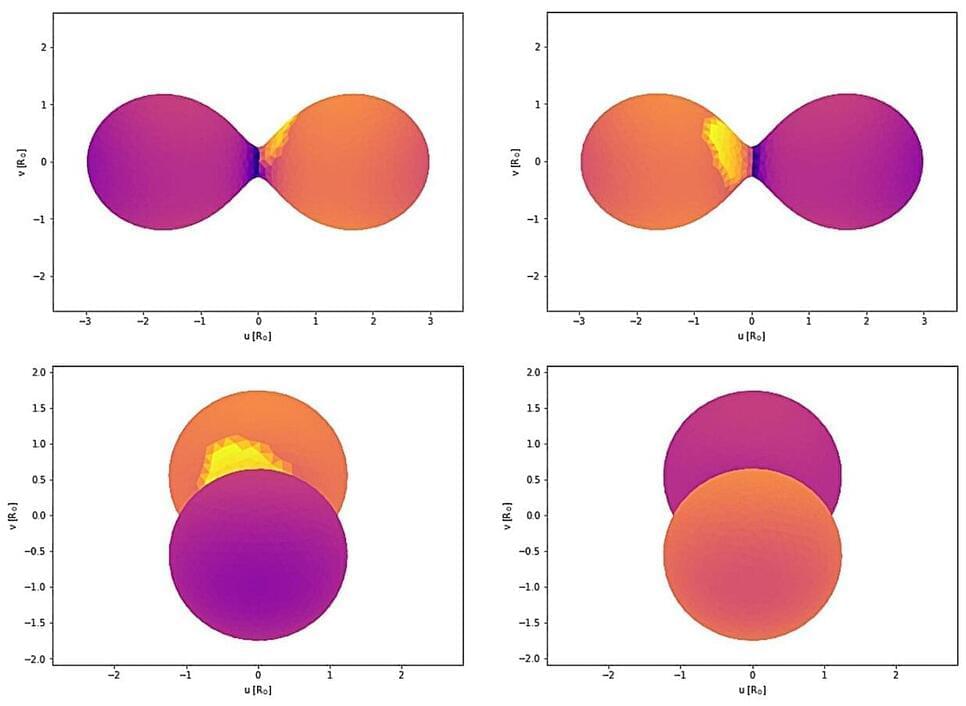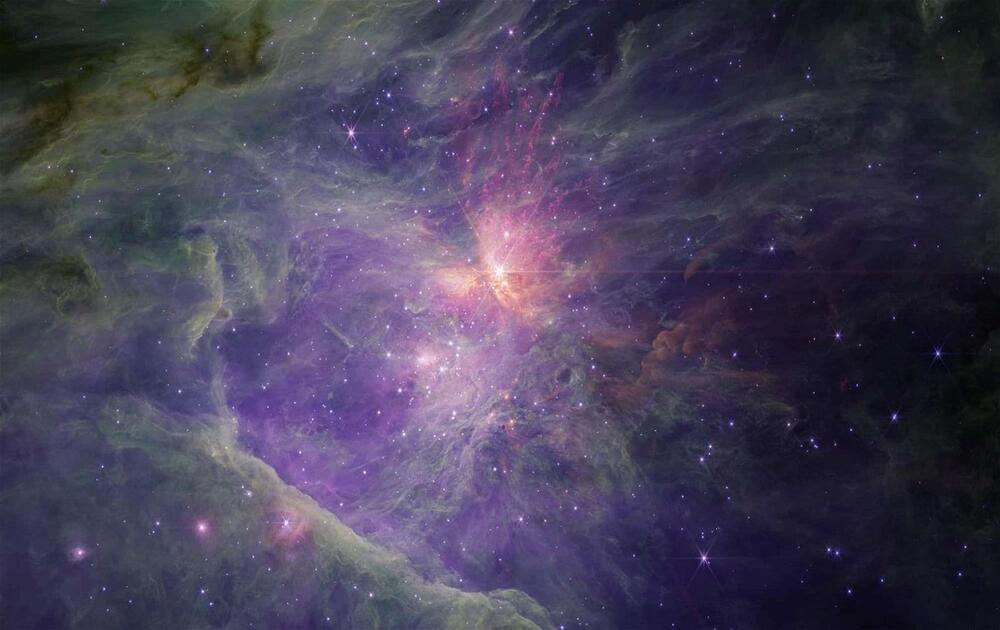Archive for the ‘evolution’ category: Page 30
Oct 14, 2023
Scientists explain unique formation of ancient algae that evolved photosynthesis and oxygenated the planet
Posted by Genevieve Klien in category: evolution
Scientists have for the first time revealed how blue-green algae—visible as the slippery green slime in stagnant water, riverbeds, and seashores—weaves itself into large weblike structures.
A team at Nottingham Trent University and Loughborough University has revealed the physical mechanism behind the geometric patterns formed of cyanobacteria, one of the oldest and most abundant forms of life on Earth, and which has played a pivotal role in the evolution of our planet.
The research, for which Ph.D. students Mixon Faluweki and Jan Cammann are co-lead authors, is published in the journal Physical Review Letters.
Do you think human beings are the last stage in evolution? If not, what comes next?
I do not think human beings are the last stage in the evolutionary process. Whatever comes next will be neither simply organic nor simply machinic but will be the result of the increasingly symbiotic relationship between human beings and technology.
Bound together as parasite/host, neither people nor technologies can exist apart from the other because they are constitutive prostheses of each other. Such an interrelation is not unique to human beings. As the physiologist J. Scott Turner writes in “The Extended Organism”: “Animal-built structures are properly considered organs of physiology, in principle no different from, and just as much a part of the organism as kidneys, heart, lungs or livers.” This is true for termites, for example, who form a single organism in symbiosis with their nests. The extended body of the organism is created by the extended mind of the colony.
Oct 12, 2023
Directing Superior Reagents for Better PCR Results
Posted by Shubham Ghosh Roy in category: evolution
Thanks to directed evolution accelerating natural selection processes, scientists are generating mutants with beneficial properties and improving functionality.
Learn more about these reagents in the new Research Products.
Directed evolution approaches are creating new reagents to help a tried-and-true technique reach new heights.
Continue reading “Directing Superior Reagents for Better PCR Results” »
Oct 10, 2023
Darwin or Kimura? Natural selection or pure chance? New literature review aims to clarify a heated debate
Posted by Dan Breeden in categories: biological, evolution, genetics
Some of nature’s mysteries have kept scientists busy for decades—for example, the processes that drive evolution. The question of whether certain differences between and within species are caused by natural selection or by chance processes divides evolutionary biologists even today. Now, an international team of researchers has teased apart a scientific debate concerning the evolutionary theories of Darwin and the Japanese geneticist Kimura. Their conclusion: the debate is unnecessarily convoluted by the co-existence of different interpretations.
Due to his contributions to geological and biological sciences, British naturalist Charles Darwin (1809–1882) is considered one of the most important natural scientists. His influential work “On the Origin of Species” (1859), with its strictly scientific explanation of the diversity of life, forms the basis of modern evolutionary biology. Darwin concluded that species evolve through natural selection: well-adapted organisms survive, others don’t.
However, by the end of the 1960s, the Japanese geneticist Motoo Kimura (1924–1994) proposed that at the genetic level, most changes in the course of evolution do not offer direct advantages or disadvantages to the individual but are simply neutral. According to his “Neutral Theory of Molecular Evolution,” first published in 1968, most of the genetic variation within and between species arises from random fluctuations of neutral mutations.
Oct 9, 2023
Promptbreeder: Self-Referential Self-Improvement Via Prompt Evolution (Paper Explained)
Posted by Kelvin Dafiaghor in categories: engineering, evolution, information science

#evolution.
Promptbreeder is a self-improving self-referential system for automated prompt engineering. Give it a task description and a dataset, and it will automatically come up with appropriate prompts for the task. This is achieved by an evolutionary algorithm where not only the prompts, but also the mutation-prompts are improved over time in a population-based, diversity-focused approach.
Oct 7, 2023
New ‘assembly theory’ unifies physics and biology to explain evolution and complexity
Posted by Dan Breeden in categories: alien life, evolution, physics
An international team of researchers has developed a new theoretical framework that bridges physics and biology to provide a unified approach for understanding how complexity and evolution emerge in nature.
This new work on “assembly theory,” published today in Nature, represents a major advance in our fundamental comprehension of biological evolution and how it is governed by the physical laws of the universe. The paper is titled “Assembly Theory Explains and Quantifies Selection and Evolution.”
This research builds on the team’s previous work developing assembly theory as an empirically validated approach to life detection, with implications for the search for alien life and efforts to evolve new life forms in the laboratory.
Oct 5, 2023
Study of 17,000 years of fish fossils reveals rapid evolution
Posted by Genevieve Klien in category: evolution
When a new island or lake appears, the plants and animals that get there first have a leg up on later arrivals and are more likely to diversify into new species—or so evolutionary biologists have long assumed. But a study of fossils from East Africa’s Lake Victoria shows that it takes more than arriving early to win the speciation race. Although several kinds of fish colonized this lake around the same time, only cichlids took off, forming 500 species in less than 17,000 years, the team reports today in.
“The paper uses a very smart [way] to find a clear answer to a longstanding question, which is why certain groups of organisms are more successful at forming many species over a short period of time,” says Claudius Kratochwil, an evolutionary developmental biologist at the University of Helsinki who was not involved with the work. The findings suggest opportunity and versatility matter more than primacy, adds George Turner, an evolutionary biologist and cichlid fish expert at Bangor University who was also not involved.
Most cases of adaptive radiation, wherein one species gives rise to many more, took place over millions of years, making it nearly impossible for scientists to figure out why that one colonizing species became so successful. But the extreme diversity within a group of fish called cichlids began to arise a mere 17,000 years ago, when the modern version of Lake Victoria began to fill where today the borders of Uganda, Kenya, and Tanzania meet. Now 500 species strong—each inhabiting a particular niche within the lake—this group’s evolution represents “the most rapid radiation event known among vertebrates,” says Nare Ngoepe, an evolutionary biologist at the University of Bern.
Oct 5, 2023
V0610 Virgo is a low-mass contact binary, observations find
Posted by Saúl Morales Rodriguéz in categories: evolution, space
Astronomers from the Binary Systems of South and North (BSN) project have conducted photometric observations of a distant binary star known as V0610 Virgo. Results of the observation campaign, published Sept. 23 in a research paper on the pre-print server arXiv, indicate that V0610 Virgo is a low-mass contact binary system.
W Ursae Majoris-type, or W UMa-type binaries (EWs) are eclipsing binaries with a short orbital period (below one day) and continuous light variation during a cycle. They are also known as “contact binaries,” given that these systems are composed of two dwarf stars with similar temperature and luminosity, sharing a common envelope of material and are thus in contact with one another. In general, studies of contact binaries have the potential to reveal many details about the evolution of stars.
Located some 1,560 light years away from the Earth, V0610 Virgo is an EW with an apparent magnitude of 13.3 mag. Although not much is known about this system, previous observations have found that it has an orbital period of approximately eight hours.
Oct 4, 2023
James Webb Space Telescope Has Spotted Something Lurking in the Orion Nebula That “Shouldn’t Exist,” and They Come in Pairs
Posted by Ron Gowans-Savage in categories: evolution, space
New images of the Orion Nebula captured by the James Webb Space Telescope have revealed the existence of 150 free-floating objects once considered a scientific impossibility.
South of Orion’s belt is one of the brightest nebulae visible in the night sky, the Orion Nebula, also known as Messier 42, which is home to the Trapezium Cluster of stars. This cluster produces extremely strong ultraviolet radiation fields that cause the surrounding gas to glow, which is the source of the nebulae’s brightness.
Within the cluster is a veritable nursery for the formation of protostars, which the European Space Agency (ESA) recently called “a treasure trove for astronomers studying the formation and early evolution of stars, with a rich diversity of phenomena and objects” that include a mysterious category of celestial phenomena known as free-floating planetary mass objects.

